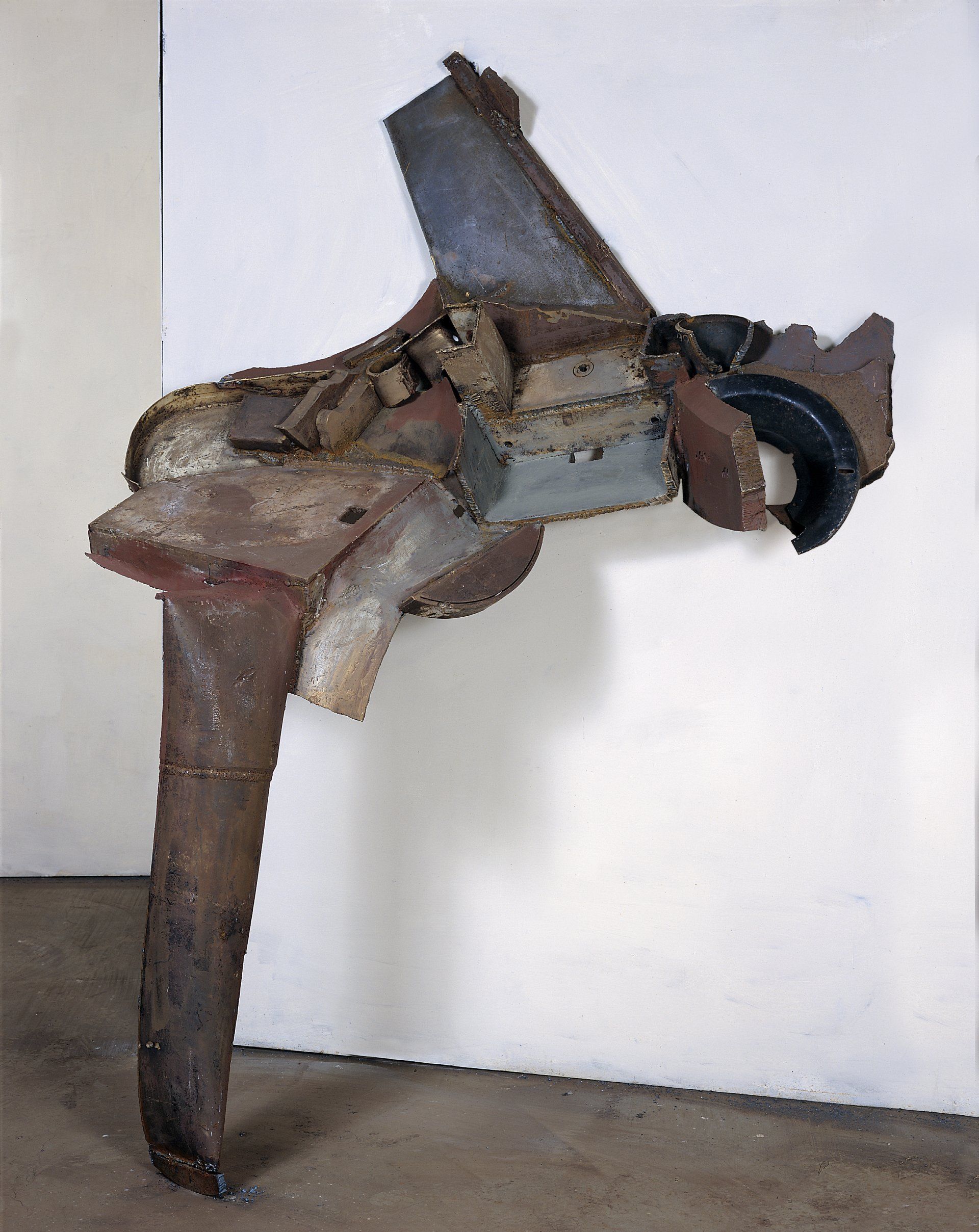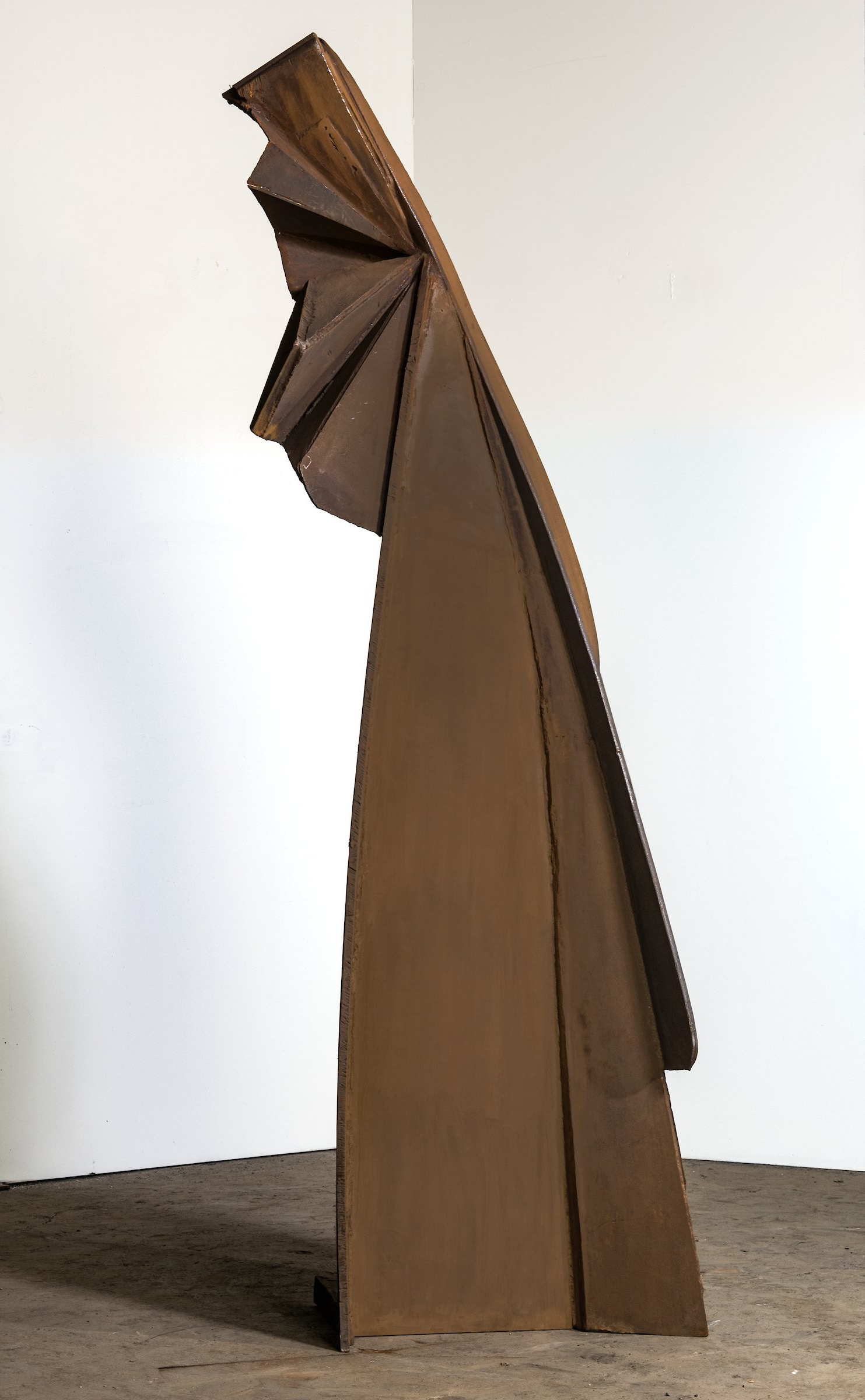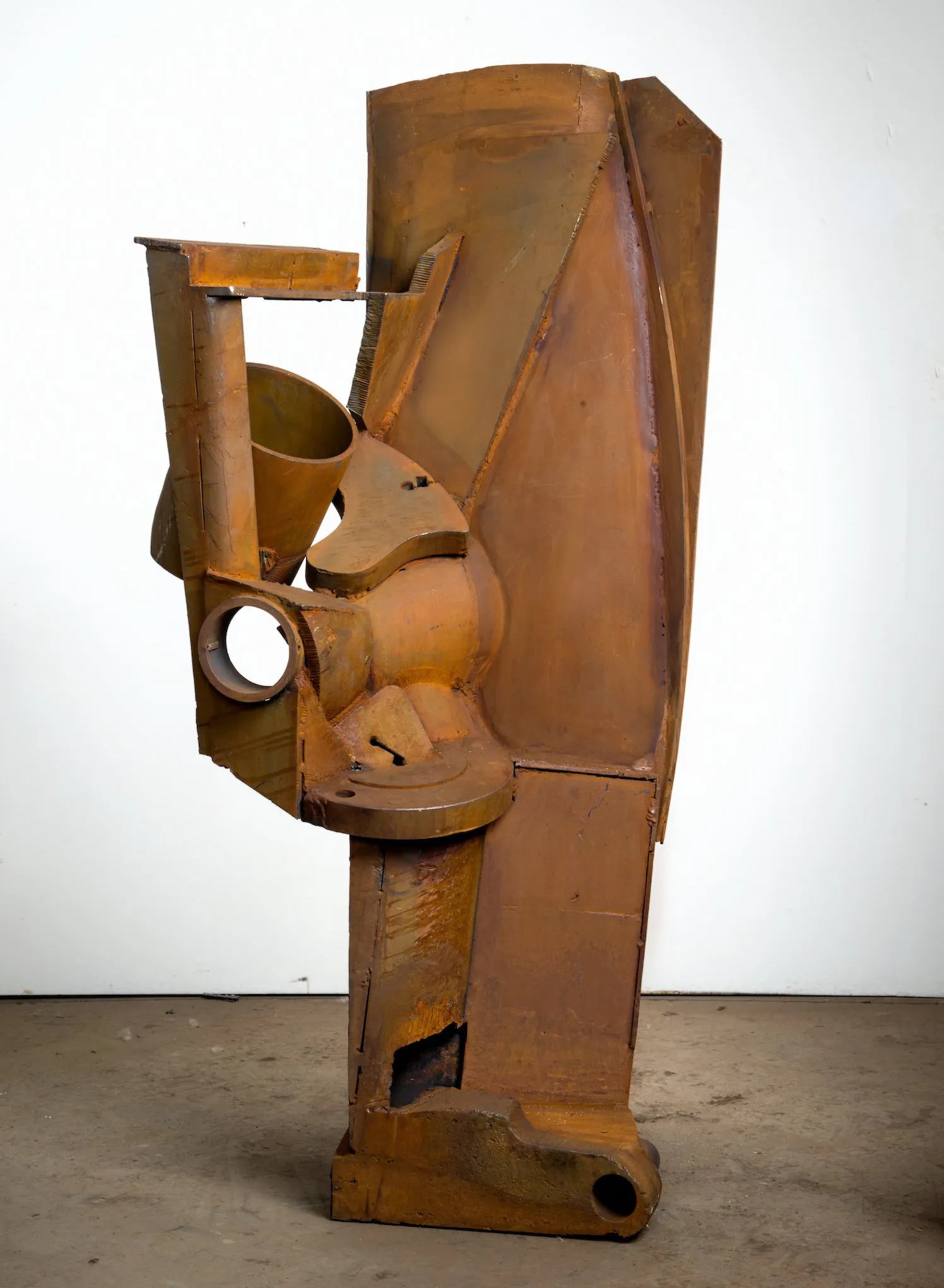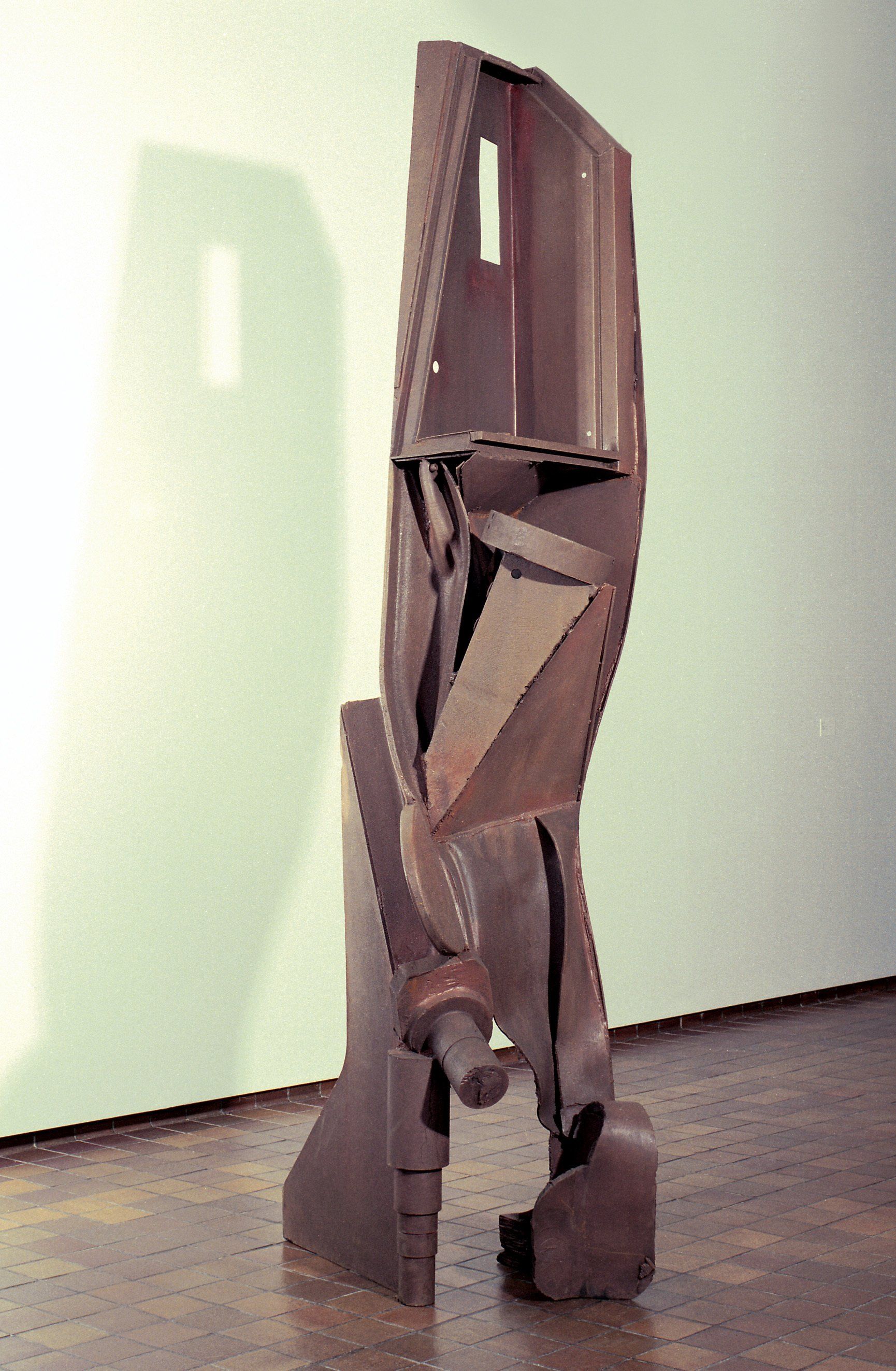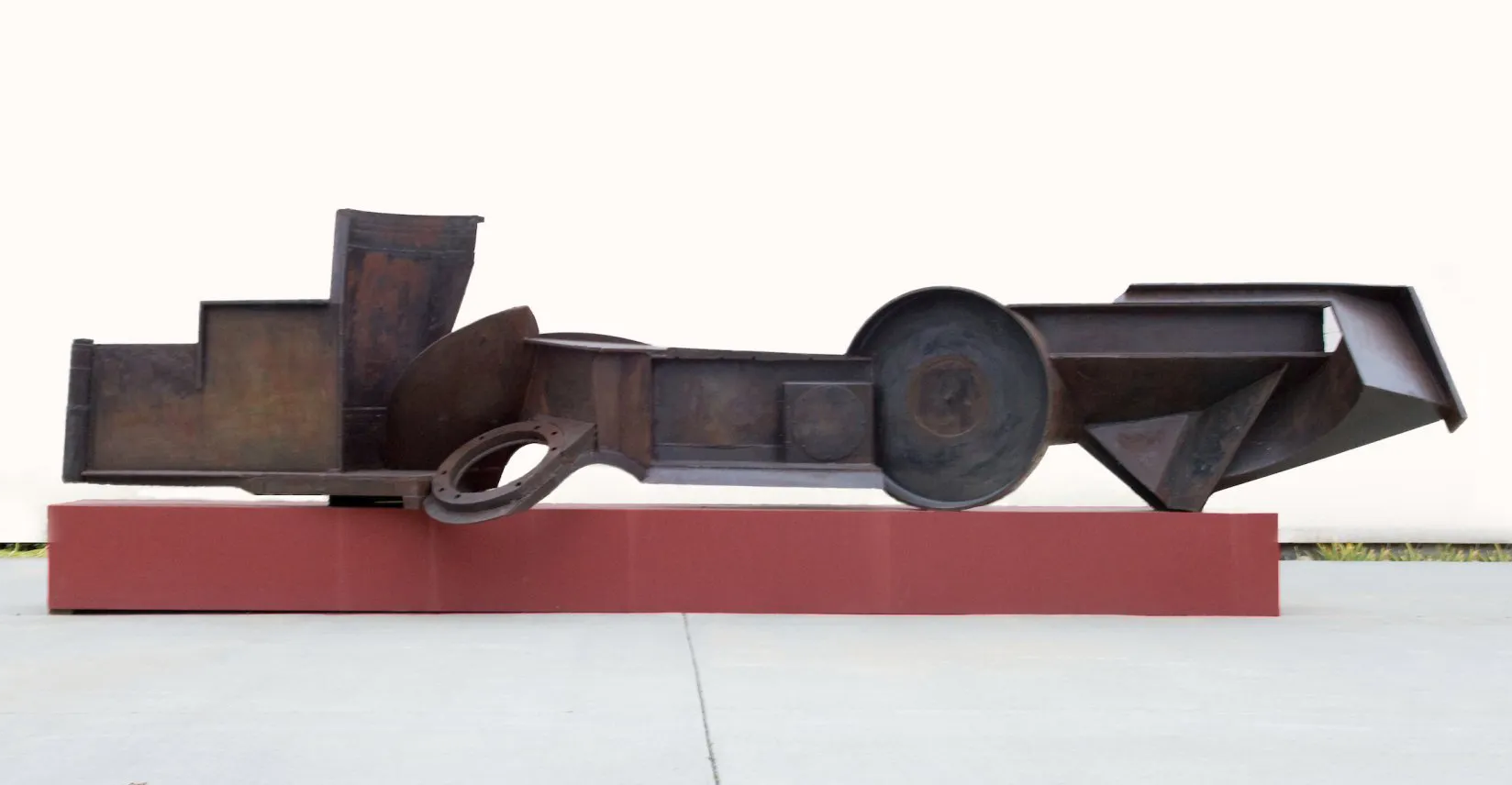Abstraction AND THE FIGURE:
My Art in Context
Revolutions in art are rare; one can usually trace a thread of development. Nonetheless, in the early years of the 20th century a true revolution occurred in sculpture. Picasso took an extra rib from cubist collage and created abstract sculpture. In a stroke he shattered the monolith that had dominated sculpture since the Venus of Willendorf.
His invention was more radical than anything that happened in painting. People can still recognize the conventions of painting in a Jackson Pollock, and while they may not think that it's a good painting, at least they know it's a painting. However, constructed sculpture in the hands of David Smith or Anthony Caro produced objects that confounded the layman's notion of sculpture in almost every way. The culmination of this trend towards abstraction occurred around 1962 with Caro's Early One Moming, roughly 60 years after Picasso's seminal "Guitar" of 1912. Because of its unlikeness to nature, its apparent weightlessness, dispersal, and denial of material Early One Morning demonstrated an extreme development of abstraction.
During the 1960s, Caro consolidated the success of Early One Morning in an almost unbroken succession of sculptures of a quality unmatched by his contemporaries. But by the early seventies the limitations of the high abstract style that Caro pioneered had become apparent. It was cold in its austere geometry and, because of its characteristic attenuation and dispersal, sculptures made in this style were hard to read except against very plain backgrounds. They only showed to full advantage in austere architectural environments. The limitations of the style produced a reaction. This reaction was not, however, a challenge to abstraction. It represented a desire rather to body forth the discoveries of abstract sculpture in a more robust and monumental form.
The first stirrings of the reaction occurred in the early sixties, in a sense ahead of their time, coincident with the high-water mark of modernism. This came in the work of the Minimalists, notably Donald Judd and Richard Serra. These artists eschewed the gesturalism and attenuation of form of Smith, Caro, Calder, etc. and concentrated on weight, volume and material character.
By 1970, a sea change was in the air: the movement to restore weight and volume to sculpture started to encompass artists regardless of their sensibility. Caro himself did an about-face from lyric abstraction of the sixties and produced a series of closed and massive wall-like sculptures composed of sawn-off sections of huge girders. However, the first masterpieces of this new sensibility were produced in the early seventies by Michael Steiner. I am thinking particularly of works like Knossos which I first saw at the Marlborough Gallery in New York in 1973, and Judgematic in the Art Gallery of Alberta’s permanent collection.
Steiner had started precociously as a Minimalist in the mid-sixties, but his was the first really successful crossover of Minimalism with the Picasso-Smith-Caro lineage. In sculptures like "Knossos," Steiner showed how to compress cubist elements into powerful masses suggestive of weight by using thickness expressively.
This, then, was the scene that I came upon as a young sculptor and recent graduate from St. Martin's School of Art. I had studied with Caro, had witnessed first-hand the nascent struggle to find an alternative to Caro-style sculpture that overtook the scene in the sixties and felt very much part of this movement. Like my peers, I wanted to restore a sense of weight and monumentality to sculpture and in particular I sought to reconcile these properties with the drawing-in-space approach of sixties sculpture. The results that I came up with, which I can best characterize as a kind of structural minimalism, did not have the expression desired and I found myself in an increasingly arid territory. It is interesting to note, though, that this phase of my work attracted considerable support from the art establishment in England, fitting in as it seemed to with the current orthodoxy that modernism should develop into Minimalism, Earth Works, Conceptual, and so on. Notwithstanding this support, I felt increasingly dissatisfied with the direction of my sculpture and was open to a way out.
It was in this frame of mind that I traveled to New York in December 1973 where I saw Steiner's show at the Marlborough Gallery and visited Clement Greenberg. I had met Greenberg almost 10 years earlier at Tony Caro's and was struck by his trenchant observations on art. Steiner's sculpture and Greenberg's criticism showed me the way through my impasse.
The challenge had been to get out of the strangle-hold of Caro-style sculpture. I had engineered my escape by going into a kind of structural minimalism. I escaped from this, in turn, by accepting Steiner's influence, which lasted for two or three years. In the mid-seventies I broke away from that influence when I made Zenith, probably the first sculpture of my maturity – certainly the one that has defined my goal as a sculptor since then. I suppose I can best describe this goal as a desire to humanize the high abstract language I grew up with in art school without compromising it. I say this with hindsight, as I certainly did not make a conscious decision. At the time, I merely wanted to stand sculpture up and in the simplest sense this could be seen as a reaction against Tony Caro's resolute horizontality.
Horizontality together with dispersal and weightlessness were the three linchpins of Caro's abstractness. Zenith set itself against all three in the way that it fused cubist elements into a vertical mass suggestive of weight, and in its emphasis on materiality. It was figure-like, and, though it was essentially flat, it was inflected in space; the frontal plane "turned" into a side view which encouraged the spectator to move around the piece to a "hidden" rear view. Of course, Zenith was not the first abstract sculpture to mass parts into a solid matrix, however I think it was new in the way it made use of a device borrowed from classical figure sculpture – contrapposto – to move the sculpture in a unified gesture.
The contrapposto pose was explored first by the Greeks. They developed it in order to get away from the frontality and stiffness of their “archaic” sculpture. It had the advantage of greater naturalism and made the body more spatially interesting as a sculptural subject. Contrapposto involves adjusting the distribution of weight in a standing figure such that one leg bears most of the weight. From this simple action, there follows a complex set of reciprocal movements that activates the body spatially. From the front there is the contrast of the straight-legged, compressive side with the relaxed side, which opens out in space, moving in depth to activate the side view.
This exploration of the dynamics of the body raises the issue of engineering in sculpture and the means by which a sculpture resists the force of gravity: what keeps it standing up. In traditional sculpture this function was largely performed by a base, which acts as a stabilizing force. Thus a dynamically posed figure when attached to a base has a stable interface with the world. Abstract sculpture, however, gradually worked itself away from the base and therefore it became necessary for sculptors to integrate the means by which a sculpture stood up with the formal and expressive conception of the piece. By 1960, both Alexander Calder and David Smith had produced abstract sculptures that confidently exploited this new state.
I wished to retain the freedom and concreteness gained by off-the-base sculpture, but wanted to combine it with the liveliness of the animated body as expressed in the contrapposto pose. This was largely my preoccupation of the early eighties and led in 1983 to The Conquest of Happiness. “Conquest” dealt with contrapposto in abstract terms and unfolded in space as one moved around it. However, it remained stiff and hieratic in feeling with something almost Egyptian in its pyramidal outline.
Rondour made the next year was my first step away from the earthbound ziggurat form of Zenith and The Conquest of Happiness. It had a rectangular as opposed to pyramidal outline and the weight, both visual and actual, was not concentrated at the base as in those other two.
This task of redistributing the weight and thereby liberating the outline was a drawn-out process. Throughout the eighties I played with structures that became top-heavy, and in that spirit produced works such as Inside Balzac, Form and Content and Happy Outlook, a work in which Russell Bingham observed "there is a sense of forces straining against each other" – as opposed, say, to straining against the ground, which you could say characterized the ziggurat phase.
Doubtless this mini-history of my development is an oversimplification. Unfortunately, events don't always follow in the logical sequence that historical hindsight assigns to them. Looking back, I'm aware, that my first experiment with a so-called top-heavy form of sculpture occurred as an isolated instance in the late seventies, seemingly unrelated to the "heavy-metal" sculptures which were my dominant preoccupation at the time. This odd sculpture was a kind of Winged Victory. Unfortunately it needed a base to make it stand. Clearly this was no solution – returning as it did to the allusive world of figurative sculpture. The image of the work stayed with me, though, not least because it represented a desire to escape the implicit but imprisoning frame of pictorial sculpture.
At the time I lacked the formal resources to solve the base problem, so it remained a statement of intent rather than a stepping stone. It took a number of seemingly unrelated events to occur before I finally solved the problem.
Next in the catalogue of "unrelated" developments were my experiments with a series of wall-related sculptures. This, too, was motivated by a desire to escape from the dense, compressive, ingot-like form of sculptures made at the time, works such as Oddball, which threatened to implode into another kind of trap. These sculptures were lighter and more open in form, and one of them actually leaned against the wall, using the wall as a structural element.
With hindsight, the wall-pieces were a manifestation of a desire to gain the freedom that unstable top-heavy forms offered. But again, I did not have the formal resources to develop these works which, with a couple of exceptions, I considered failures. At the time the exceptions did not seem susceptible to development.
During the late eighties, I taught a life drawing class in which I examined the development of the posed figure from Giotto through Donatello to Michelangelo. I was interested in the way the treatment of the figure gradually became liberated by degrees from the hieratic stiffness of Byzantine art, finally culminating in the spatial emancipation of Michelangelo's Sistine Chapel figures. At this point, I became directly interested in the human figure as a subject for sculpture, and concluded the drawing class by placing the model in a series of dynamic poses in which she would assume an unstable position using the wall as a prop.
These rather anguished poses which perhaps were a response to the cringing figures of Adam and Eve being banished from the Garden of Eden in Michelangelo's mural – had a practical value: they showed how a figure posed dramatically could link the floor to the wall in a new way. I say this, though, with hindsight. Although I felt a powerful urge to deal with these images, I lacked the formal resources to do so. Once again an idea was shelved and I literally moved sideways into a horizontal format.
The horizontal experiment was driven initially by a desire to expand my territory. I felt it might help me overcome a residual stiffness that lurked in the verticals. This venture into the horizontal was risky; this was an area Caro had dominated and, after all, I had marked myself apart from him in part by going vertical.
The impetus to go horizontal was considerably reinforced by a visit to Florence in 1993. There I was particularly impressed with Michelangelo's Medici Tomb figures. I was especially interested in the figure of Dawn, not only because of its easy mastery of the horizontal format but also because it showed how to relate the wall to the "floor" – in this case an architectural scroll-like platform at head height on which the nude figure languorously disported herself. Fortunately, I had moved to a new studio in late 1992, one which enabled me to work on a series of more expansively horizontal pieces. This approach led my sculpture towards architecture and culminated in Malevitch Extended.
With hindsight, I think this sculpture represented an extreme departure from the figural form in which I had originally established my territory. Initially I was seeking a way back, or rather a synthesis of the horizontal and vertical. This impulse towards a synthesis had appeared in the form of Hindu Laocoon which, while sprawling on its base, depended as well on a leg-like form which stood directly on the ground. This awkward piece, I later realized, was a development of the 1978 "winged-figure" motif that I had abandoned and, like this motif, it had a support problem. It needed a base because of its unstable, top-heavy configuration, but nonetheless the base was extraneous to its form. The next step was to do away with the base, but how?
The answer came to me eventually when I remembered the life-drawing poses of figures pressing against the wall. I could do away with the base if I used the wall instead! In a sense the wall is a prop, but it's more neutral and undifferentiated than a base, which has an unwanted sculptural presence.
In the development of these new wall-leaning pieces, I've sought to capture something of the free outline of a body in motion without compromising abstraction. I've tried to achieve this by opposing contrasting scales; the scale of the outsize leg with that of the parts of the horizontal "torso' section of the sculpture. These parts are not only smaller, but – to me at any rate – carry in their entire relationship something of the feel of a landscape. In this way they "cancel" the figure image and once again render the sculpture abstract.
* * *
Looking back over what I've written I'm aware that it suggests some kind of heroic struggle coupled with an increasing mastery over what I do. One thing I can say is that it doesn't get any easier to make sculpture – even if the formal problems I deal with are more complex, the demands on will and feeling to complete a work remain daunting.
I'm aware, also, that on the large scale of art history, there is no such thing as progress, however I think that progress can apply in individual lives and can be seen as mirroring the growth from childhood to the adult state. I would go farther and say it can occur in the consecutive lives of artists, in which case a tradition emerges such as I've sketched out in my discussion of the developments leading up to the Renaissance and Michelangelo – or, for that matter, to High Modernism.
When we look at the state of art today, it seems hard to escape the idea that if improvement in art doesn't really occur then disintegration and decay certainly do. It's difficult to keep faith in the potential of art to be life-affirming and spiritually uplifting in the face of the colossal act of dismantling that is taking place in our culture today, yet I do believe that good art will come out on top sooner or later.
Peter Hide
